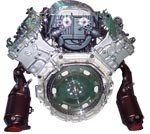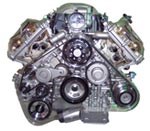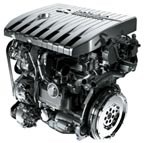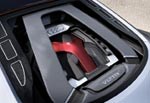Is The V8 Dead?
Tougher fuel economy standards may be the end of most V8s.
#economics
Mass-produced V8s have lasted for 94 years. Cadillac was the first in 1914, when it launched a V8 with closed-head, cast-iron cylinders bolted to an aluminum crankcase. Thirteen thousand of these engines were sold that year. Eighteen years later, Henry Ford jumped straight from four-cylinder engines to the 1932 flathead V8. It was the first volume V8 with a block produced from a single casting, and took years for Ford to ready it for production. (Ford disliked the inline six-cylinder engines favored by his competitors because he felt the crankshafts were long and prone to breakage.) In the 1960s there began the proliferation of large-capacity big-block V8s, and while the oil embargoes of the 1970s had an impact on the number sold, the V8 soldiered on. But is their mass-produced life coming to an end?
One sign that the V8 could be on its last legs is GM's recent cancellation of the Ultra V8, a replacement for the aging Northstar engine. GM vice chairman Bob Lutz admits the cancellation "was a direct result of the 35-mpg CAFE legislation." In its place we will see a turbocharged direct-injection V6 tuned for low-end torque. According to Lutz: "That's a relatively inexpensive-$1,500 to $2,000-solution that will get you part of the way to 35 mpg." But what of the V8? GM's self-proclaimed performance enthusiast speculates, "I think V8s will remain," before adding the kicker: "But no one will be investing a ton of money in families of new V8s, unless it's a small specialty company." Presumably, that means this small specialty company won't be mass producing these engines.
Lutz is joined in this line of reasoning by Frank Klegon, Chrysler's executive v.p. of Product Development, who suggests that the days are numbered even for the firm's five-year-old Hemi V8. "You're going to have trucks for a while in the V8 game," he says, "but there will be greater separation between what goes on in the car world and the truck world to the point where there aren't going to be too many V8s in the future." Ford has already stated its intention to replace the bulk of its V8 lineup with its turbocharged and direct-injected 3.5-liter EcoBoost V6, even to the point of offering this engine in the F-150 pickup. Jim Press, vice chairman and president of Chrysler, suggests that one alternative would be to take the 5.7-liter Hemi introduced in the new Ram pickup and "make a Hemi hybrid." This would use the two-model system developed by the then-DaimlerChrysler, GM, and BMW. "You could build big trucks and get good mileage on the highway," he says.
Nevertheless, the number of V8 engines is scheduled to increase in the short term as new players enter the light truck and luxury segments, and established competitors introduce new designs. Over time, you can expect automakers to offer powertrain lineups closer to those seen in Europe, with V8s occupying a niche in the high-performance and upper luxury segments. This would leave each domestic automaker with one lightweight V8 engine family of about 4.0 liters that sports a combination of technologies from variable intake and exhaust valve timing to direct injection to turbocharging to keep both fuel economy and power output high.
RELATED CONTENT
-
Report Forecasts Huge Economic Upside for Self-Driving EVs
Widespread adoption of autonomous electric vehicles could provide $800 billion in annual social and economic benefits in the U.S. by 2050, according to a new report.
-
Mazda, CARB and PSA North America: Car Talk
The Center for Automotive Research (CAR) Management Briefing Seminars, an annual event, was held last week in Traverse City, Michigan.
-
On The German Auto Industry
A look at several things that are going on in the German auto industry—from new vehicles to stamping to building electric vehicles.






